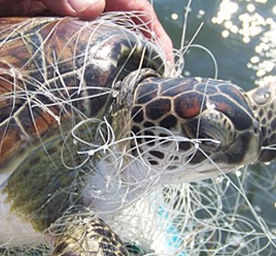
The North Carolina Division of Marine Fisheries director has proposed closing a large section of the state’s estuarine waters to large-mesh gill nets between May 15 and Dec. 15, according to the Coastal Conservation Association of North Carolina.
The CCA-NC reported Jan. 13 5that NCDMF Director Louis Daniel sent a letter suggesting the closure to National Marine Fisheries Service Regional Administrator Roy Crabtree.
Under the proposal, gill nets with mesh larger than 3 1/2 inches would be prohibited between May 15 and Dec.15 in areas to include much of Pamlico Sound, Core Sound, Back Sound, and the Cape Fear River.
The closure is deemed necessary to prevent violations of the Endangered Species Act (ESA) as sea turtles may swim into the nets, become entangled and drown, the CCA-NC reported.
North Carolina currently has a Section 10 permit, which provides an exemption from the ESA, for a section of the Pamlico Sound. In this area, fishermen are allowed several hundred interactions with sea turtles each year. This area would not be affected by the proposal.
Small-mesh gill nets, or those with mesh less than 3 ½ inches, are not considered as much of a threat to the turtles and would be allowed in the proposed closed areas. However, the small-mesh nets must be attended during the times when the areas are closed to large-mesh gill nets.
This closure is only an interim measure to prevent violations of the ESA in these areas while NCDMF applies for a Section 10 permit for the entire state.
The proposal is to be heard by the Marine Fisheries Commission during at its March 24-25 meeting in Kitty Hawk. If the MFC votes to accept the proposal,. Daniel will issue the rule by proclamation immediately thereafter.
CCA-NC applauded this temporary move, but noted that Daniel and the MFC must make permanent measures to eliminate the use of destructive fishing gear from North Carolina estuarine waters and ensure a healthy future for the coastal resources. CCA-NC also said they will continue to work with the MFC and Daniel to ensure proper management of North Carolina’s marine resources.
Dean Phillips of the Coastal Fisheries Reform Group, which is working closely with the Karen Beasley Turtle Rehabilitation Hospital on their efforts to remove all gill nets from N.C. waters, felt this proposal isn’t enough.
“Dr. Daniel states that there have been no reported interactions with sea turtles in most of North Carolina coastal waters,” Phillips said. “If this is the case, then why does the North Carolina commercial fishing industry need a statewide Section 10 permit?
“The most glaring issue that most people need to understand is this: The request for a statewide Section 10 permit will require the National Marine Fisheries Service to enable North Carolina commercial fishermen to kill literally thousands, not hundreds, of endangered and threatened sea turtles. I suspect that the public comment on this will be an enormous obstacle for Roy Crabtree to overcome.”
He went on to say that he believed the proposal to be a political move.
“What we see here is the perfect example of marine fisheries managed by politics instead of science¸” Phillips said. “Until the day comes when that is reversed, North Carolina’s marine resources will remain in a constant state of ‘crisis and search and rescue,’ where the true goal should be ‘preservation for all generations.’




Be the first to comment